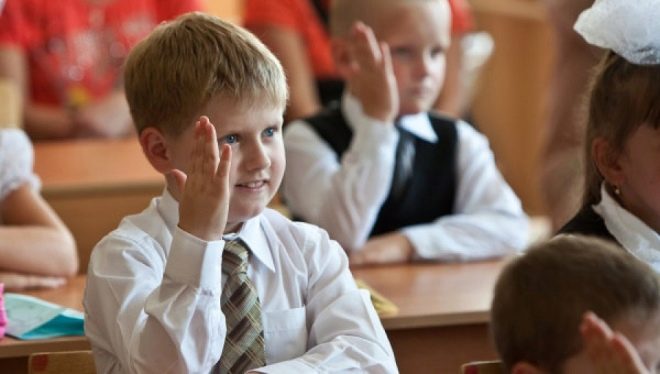Basic rules for student behavior at school
Most parents are faced with violation of the rules of behavior at school by their children. At the same time, in some cases the child’s fault is not so obvious, especially if it is quiet and refers to unreasonable attacks from classmates and teachers in their address.
Sometimes a child, even with positive behavior for one reason or another, stands out from the crowd, which can provoke his rejection by the team. To avoid such situations, parents should know the modern rules of behavior of students in school.
Special features
Many problems in school appear because children here feel uncomfortable. The reason for this can be both an unfriendly environment, and the banal rejection of the fact that outsiders are constantly imposing certain tasks on the kid, even if their parents have told them to obey. The perception of the school as a place where students have only duties leads to a loss of motivation and a decrease in interest in learning new things.
It should be explained to the child that he has not only duties, but also certain rights.
The rules of conduct in any modern school must comply The new law on education, which defines the following rights for a student.
- School course should be read to the child as fully as possible. He has the right to do so according to the Constitution. This means that there is not a single legal basis to remove a child from an activity, even if he clearly violates discipline. None of the educational institutions is also unacceptable to refuse a student to attend a lesson if he came to him after the call.
- The school is designed for learning, not for maintenance.. No one has the right to force a child to engage in work on the street or indoors. The historical epoch of obligatory subbotniki is long gone. The same applies to cleaning the classroom. However, such events can be held subject to the involvement of participants on a voluntary basis. Refusal to participate should not become a reason for bias.
- There is a general education program, mandatory for study for all without exception.however, everything that does not belong to it cannot be a priori mandatory. One can only greet the desire of teachers to organize additional electives, creative circles or amateur performances, but one should not force a child to attend such classes if he is not interested. Even veiled assignments on the type of minimum time spent in the library, rehearsals in the assembly hall, materials that are independently studied at home can be rejected by the child as unfounded if they are not in the program. Even a conditional quiz by a particularly pedantic student can be rejected as the wrong teaching method.
- According to the Constitution, in our country everyone is entitled to free education. This is perhaps the most controversial point that is not respected. If speaking theoretically, teachers are not allowed to collect money even for any conditional class fund, not to mention cleaning or guarding the school. The legal exception is a boarding school, where children live permanently during their studies, but there they have fundamentally different needs.
It should be noted that the school is still not an army, so not all norms are regulated at the national level.The pedagogical board of an institution may determine its own rules of behavior in some parts of the school, for example, in the cloakroom or dining room.
How to dress properly?
A person is known to be “greeted by clothes,” and by the appearance of the student, not only him, but also his parents are judged. It should be noted that children, on the one hand, strive for self-expression in any way and do not always correctly evaluate their own appearance, on the other hand, they are rather cruel to their peers. They often strongly oppose views that differ from their own.
Legislation does not introduce a single concept of school uniform, therefore, in all institutions of the country the management independently makes the decision on obligatoryness of this or that dress code. Many schools literally force their students to buy the same clothes, which has its advantages and disadvantages.
Many have criticized this approach for excessive unification and depersonalization of children who lose their own individuality, as well as for increased waste, because you have to order or buy a school uniform, and you can’t wear such a suit anywhere, except for school.
Nevertheless, there are also advantages in strict observance of the norm, since under such conditions the likelihood of the appearance of pupils of a defiant appearance, going against the rules that are the same for all, is reduced.
In the conditions of a multinational state in which carriers of different religions and traditions live, this approach seems to be justified. In addition, the appearance of children from families of different wealth is no different.
However, many schools still leave the choice of the dress code to the parents or the students themselves. This allows students to remain themselves, and parents do not spend resources on finding the optimal costume, because it is enough to dress the child in casual clothes.
Cleanliness and tidiness without defiant details in such conditions constitute the key to success, however, there remains the risk of hypertrophied self-expression, which will not be perceived by the collective, which will entail tensions within the school.
However, even in schools with a free style of clothing, no one forbids parents to wear a child in uniform. White top (shirt - for boys, blouse - for girls) and black bottom (trousers - for both sexes, and for girls - also skirts) are considered to be common and not irritating to anyone. A jacket or a vest can also be added on top.
Even free-form establishments require a neat appearance from students. It is unacceptable to wear even a classically correct suit, if it is dirty, rumpled or torn.
With regard to shoes, there are special requirements for cleanliness. Many schools consider it necessary to oblige students to carry a replacement pair of shoes with them in order to change their shoes when entering the school.
The separate moment is a hairstyle of the school student.
Preference should be given to the hairstyles of the classic style, while the modern ways of “self-expression” (unnatural hair shades that cause forms like Iroquois or shorn “zero” head) are considered undesirable.
How to behave in the classroom?
The main problems with the discipline of students in school arise from the fact that they are unduly distracted from the class or, worse, interfere with the normal conduct of the lesson in the class with their antics.
To instill the child the rules of etiquette in a secondary school can not a single teacher, if this is not done by parents at home.
The right manners are most often not in those children who regularly attend a voluntary hour to attend, and for those to whom parents, even before going to the first class, lucidly explained the basic rules of behavior with their elders. The main thing that psychologists point out is not to give out the list of axioms, but to clearly explain to the kid why it is impossible to do certain things.
It might look like this:
- Come to class earlier for 5-10 minutes.This will allow not to run and once again not to apologize for being late, disturbing classmates.
- Always take your seat. This will allow you not to offend any of your classmates, as well as reduce the risk of offending you yourself, including a note in your diary.
- Foreign objects on the table during the lesson is not needed. They distract from classes, which would entail a longer mastering of the material and homework. Reduced time allotted to rest.
- No need to make noise in the classroom. Perhaps some classmates are interested in what the teacher is now telling. Mutual respect in the team will make them not to make noise when they tell something that will be interesting to you.
- If you really need to leave the class during the lesson, you should raise your hand and ask for permission. This is a sign of respect for the teacher, who works hard to make each of the children an intelligent and successful adult.
- If you need to ask something or you want to answer the teacher's question, you also need to raise your hand and wait until you are called. This allows you to conduct a lesson in silence, not to miss information that might be useful.
- One should not shout out and suggest the correct answers if asked by another student. This is impolite, and you will embarrass a classmate who may know the right answer.
Change behavior
The change is the most favorite part of the working day for most students, because at these moments they are actually left to themselves. It is important to teach the child the rules of good behavior. Then the baby will not have problems with the administration of the institution and, most likely, with other schoolchildren.
This task is assigned more to the parents, since it is more likely upbringing than training. Parents should teach your child the principles of polite treatment of others, because the basic rules of behavior will be useful to the child even after graduation.
To convey to the baby you need the following:
- Call for change - exclusively for the teacher. He has no right to take away the change from the children at all, but at least out of respect one should give him a couple of minutes to finish the thought.
- You shouldn’t sit on windowsills or open windows, even if you really want to. The window sill can not withstand the weight of its "passengers" and collapse, and the open window will cause drafts and the resulting diseases. Even a small child should understand why this is bad.
- In the corridor at recess, there is a huge chance of a collision, so here, as on the highway, you should follow the rules of the road. It is always better to walk on the right side; reduce the level of speech activity to a low volume so as not to stun those around you. It is not necessary to push and especially to beat other children. For younger students, the rule concerning girls is also relevant: it is impolite to pull their hair.
- In common areas such as the dining room or toilet, should stick to the queue. In no case can not withdraw from her standing in front of kids.
- It is also unacceptable to litter or spoil the property of the school, to draw unauthorized graffiti on the walls.
How to communicate with the teacher and other students?
The school teaches not only general education subjects, but also life, in particular, particular behaviors in the team. In the relationship between children, problems most often arise, because children are cruel by nature, they like to offend each other because of immature age. Parents should explain to the child the general principles of communication: tell what ethics is, how respectful conversation is conducted.
Even if this baby is brought up well, there is always a bully nearby, so the student must be able to give verbal resistance to the attacker. However, culture should also remain a priority here.
Simple rules also include respect for the property of other children. It is not allowed to take their belongings without permission.One should not get into other people's conflicts, except for the purpose of terminating them.
The teacher must be treated with due respect. This item includes not only timely homework, but also proper etiquette. This should be done not even because the teacher is older, but more because of his higher level of intelligence, and also in the form of gratitude for sharing his knowledge, making each of his students smarter.
Although many modern companies switch to addressing each other without a patronymic, albeit in a respectful manner, the teacher should always be referred to “you” by name and patronymic. A smarter person should always listen without interrupting.
For the child, the teacher must be an unquestioned authority, and his assignments, which are directly related to the training, must be performed without dispute. As an additional sign of politeness, it is recommended that you also get up when the teacher enters the classroom before starting the lesson.
Using a mobile phone at school
A relatively new phenomenon in the school process is the massive use of mobile phones, after all a dozen years ago, students with this technique could be counted on the fingers. Today, even among first-graders, it is difficult to find such a student who would not have a gadget, and this is on the one hand good, because parents have every right to know where their child is, whether everything is in order.
However, modern technology often harms the learning process.. First of all, children stop communicating with each other even at recess, because they are too passionate about their own smartphones. They are also not interested in lessons, because instead of them you can play, listen to music or watch a movie, chat with friends on social networks. You can even read a book, but not the one that is included in the school curriculum, but corresponding to your own interests.
It is because of the need for parents to communicate with the child, schools cannot ban the use of mobile phones at all, but parents should teach the kid that At school, the gadget can not be used just like at home. Teachers in the classroom need to listen at least out of politeness, even if the topic they are telling is not at all interesting, even if it seems that it will never be useful in life.
You can use the phone only at breaks, and as an exception - and in class with the permission of the teacher for example, for searching online educational information.
However, even at recess, it is not worth plunging into the digital worlds with your head, because for the development it can be much more useful to experience live communication with real people.
The basic rules of behavior are disclosed in the following video.



























